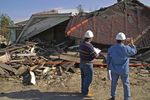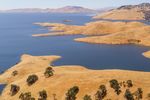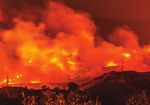GEO-EXTREME 2021 - www.geo-extreme.org - Geotechnical Engineering for Extreme Events - Alert Geomaterials
←
→
Page content transcription
If your browser does not render page correctly, please read the page content below
CALL FOR SUBMISSIONS:
Abstracts, Panels, Technical Sessions & Short Courses
GEO-EXTREME 2021
Savannah, Georgia | August 15-18
ASCE Specialty Conference
Geotechnical Engineering for Extreme Events
Geo-Institute (GI)
www.geo-extreme.orgGEOTECHNICAL ENGINEERING FOR EXTREME EVENTS
Geo-Extreme 2021 aims to create
Extreme events and geo-hazards a multi-disciplinary forum to discuss how the
Weather and climate disasters have resulted in over $1.8 trillion geo-engineering community can work with other
losses and 13,249 deaths in the United States since 1980. Historical professionals, e.g., climate scientists, engineers,
records show that the number of billion-dollar disasters is on the
emergency managers, resilience and sustainability
rise. The 1980–2019 annual average is 6.5 events exceeding $1
investigators, insurance experts, and policy
billion damages/costs (CPI-adjusted) whereas the annual average
makers, to properly cope with extreme events
for the most recent 5 years (2015–2019) is 13.8 events. 2019
(such as hurricanes, floods, extreme precipitations,
is the fifth consecutive year (2015-2019) in which 10 or more
droughts, wildfires, debris flows, earthquakes,
billion-dollar weather and climate disaster events have impacted
tsunamis, landslides) under a changing climate.
the United States. Over the last 40 years (1980-2019), the years
with 10 or more separate billion-dollar disaster events include Geo-Extreme 2021 strives to
1998, 2008, 2011-2012, and 2015-2019. Despite uncertainty
achieve the following objectives:
in the projections most climate models suggest an increase in both
frequency and intensity of extreme events under climate change. ■ To share the lessons learned from the impact
Further, earthquakes are estimated to cost the nation $6.1 billion of recent extreme events on the performance
annually in building stock losses. The 1886 Charleston earthquake of infrastructure and geo-structures (e.g.,
with an estimated moment magnitude of 6.9–7.3 caused 60 deaths embankments, dams, levees, slopes, walls,
and $5–6 million in damage to 2,000 buildings in the southeastern foundations, pavements, tunnels, landfills,
United States. The number of recorded earthquake has increased earth retaining systems, foundations).
dramatically in several regions, particularly within the central and ■ To share current and potential future applications
eastern United States, over the past few decades partly attributed of extreme value analysis and climate modeling
to human activities such as high pressure fluid injection associated in geotechnical practice and design.
with geo-energy technologies. There is a critical need to quantifiably
assess and enhance the resilience of geo-infrastructure systems,
■ To share the latest research advances on how
which form a key component of the nation’s critical infrastructure the rate and variability of a changing climate
systems. Mitigating the consequences of future extreme events will affect recurrence intervals and severity of
require geo-professionals to take timely actions including, but not climatic extremes.
limited to: evaluation of existing earthen structures, design and ■ To share recent advances regarding soil
construction of protective structures in areas where an increased behavior under climate extremes.
probability of damage is expected, refinement of existing geo-system ■ To share recent advances, challenges,
designs, and development of new climate-adaptive measures and and areas of future research regarding the
risk assessment tools. Realistic models of short and long-term loading effects of individual and compound climate
patterns will need to be developed and evaluated for the design and
extremes and natural hazards on the short-
construction of protective earthen structures. While several large-scale
term and long-term behavior of infrastructure
studies have been conducted to evaluate various aspects of climate
and geo-structures.
change, there is a clear gap in the state of knowledge in terms of
assessing the performance, resilience, and risk of man-made and ■ To highlight the use of risk in the proposal
natural geo-systems to extreme events in a changing climate. This and design phases of projects to allow
assessment requires quantifying the impact of climate change on stakeholders to understand the potential
geo-infrastructure, by accurately assessing the resistance (e.g., soil impact of climate extremes on infrastructure
shear strength and compressibility, reinforcements, stabilization, etc.) and geo-structures.
and demands (e.g., loads imposed to the structure due to climate
extremes). Hence, the geo-engineering community needs to closely Conference Co-Chairs
collaborate with experts and scientists from other related disciplines, Timothy D. Stark, Ph.D., P.E., D.GE, F.ASCE, University
e.g., geosciences, hydro-climatology, coastal, ports, risk assessment, of Illinois at Urbana-Champaign
climate science, remote sensing, structural engineering, urban Farshid Vahedifard, Ph.D., P.E., M.ASCE, Mississippi
planning, emergency management, and other areas, to address State University
future extreme events.
Geo-Extreme 2021: Geotechnical Engineering for Extreme Events 2Gateways to a World of Opportunities
About the Conference
The Conference Organizing Committee is planning a technical program
that includes state-of-the-art contributions addressing all facets pertaining
to the challenges and opportunities that the engineering profession faces
dealing with extreme events in the face of climate change. Submissions
in different forms (abstracts, technical session proposals, panel proposals,
and short course proposals) are solicited on various topics related to the
main theme of the conference. Technical sessions will contain multiple
technical tracks delivered concurrently, and will be 90 or 120 minutes in
duration. A panel discussion is an instructional technique using a group
of people chosen to discuss a topic in the presence of an audience. The
panel should not exceed four (4) individuals with a moderator/facilitator
to facilitate the discussion and the question and answer period from the
audience. The Q&A session is typically between 10 to 20 minutes in
duration.
Conference Topics
Extreme events and geo-hazards of interest include tropical cyclones and
hurricanes, extreme precipitation, floods, droughts, heatwaves, wildfires,
ice jams, snowpack, snowmelt, debris flows, natural and man-made
earthquakes, tsunamis, land subsidence, and landslides.
■ Topic A: Case Histories, Lessons Learned, and Best Practices
■ Topic B: Anticipation, Preparedness, Response and Recovery
from Extreme Events
■ Topic C: Risk Management of Extreme Events
■ Topic D: Decision Making and Planning for Extreme Events
■ Topic E: Climate-Resilient and Adaptive Infrastructure Systems
■ Topic F: Sustainability under Extreme Events
■ Topic G: Big Data and Data Analytics for Extreme Events
■ Topic H: Climate Model Simulations and Predictions
■ Topic I: Modeling and Assessing Compound and Cascading
Events
■ Topic J: Instrumentation and Remote Sensing of Extreme Events
and Their Impacts
■ Topic K: Natural and Man-Made Earthquakes and Associated
Geo-Hazards
■ Topic L: The Arctic and Cold Regions
■ Topic M: Coastal Sustainability and Resilience Under Extreme
Events and Changing Climate
■ Topic N: Civil Infrastructure and Geo-Materials Under Extreme
Loadings
www.geo-extreme.org 33Topic Areas
seitinutroppO fo dlroW a ot syawetaPast
G Exhibitors/Sponsors
Submission Types and Guidelines
Abstracts ■ Authors of accepted full papers are Panel Proposals
■ Abstracts may only be submitted via the required to sign the ASCE Copyright ■ Panel proposals may only be
online CATALYST Submission System at Transfer Agreement during the submission emailed to Jay McKelvey at jaym@
https://catalyst.omnipress.com/asce_ process, stating that: (1) all authors listed earthengineering.com.
geo-extreme2021. on the manuscript are aware of their
■ Proposals cannot contain images, tables,
authorship status and qualify to be authors
■ Abstracts are expected to be between or other graphic elements. Do not include,
on the manuscript, (2) all content, figures
200 to 300 words. (drawings, charts, photographs, etc.), keywords, HTML formatting codes, or
■ Abstracts cannot contain images, tables, and tables in the submitted work are data from other database fields.
or other graphic elements. Do not include, either original work created by the authors ■ Proposals shall include: (a) panel title, (b)
keywords, HTML formatting codes, or listed on the manuscript or work for which name(s) and contact information of panel
data from other database fields. permission to reuse has been obtained moderator(s), (c) sponsoring organization
■ Authors may select between two paper from the creator, and (3) the author and/or committee (include primary
types to indicate the intended format of transfers copyright to the ASCE. contact person and contact information),
their final submission: Technical Paper (6 (d) scope or brief description of the
Technical Session Proposals proposed panel (limited to a maximum
to 10 pages in length) or Case History ■ Technical session proposals may only
(12 to 15 pages in length). of 300 words in length), (e) proposed
be emailed to Jay McKelvey at jaym@ panelists with full names and affiliations, if
■ Submissions must include the full formal earthengineering.com. known.
names, credentials, affiliations, contact ■ Proposals cannot contain images, tables,
information and email addresses for all Short Course Proposals
or other graphic elements. Do not include,
authors. ■ Short course proposals may only be
keywords, HTML formatting codes, or
■ After submission, abstracts will be data from other database fields. emailed to Jay McKelvey at jaym@
reviewed and organized to form a earthengineering.com.
■ Proposals shall include: (a) session title, (b)
cohesive conference program. Authors ■ Short course proposals shall identity either
name(s) and contact information of session
of accepted abstracts will then be invited leader(s)/proposer(s), (c) sponsoring full day or half a day courses.
to submit a full paper for the conference organization and/or committee (include ■ Proposals shall include: (a) short course
proceedings. Full papers will be peer- primary contact person and contact title, (b) name(s), contact information,
reviewed and accepted papers will be information), (d) scope or brief description and short bio of short course instructor(s),
published in a series of ASCE Special of the proposed session (limited to a (c) sponsoring organization and/or
Publications. maximum of 300 words in length), (e) title committee (include primary contact person
■ Submission and acceptance of a full of each presentation, if known, and (f) and contact information), (d) learning
paper for the proceedings is required for proposed speakers, if known. objectives, (e) benefits for participants, (f)
both podium and poster session authors, who should attend, (g) tentative course
prior to presenting their work at the outline.
conference.
www.asce.org/conferences/pavements2013
Geo-Extreme 2021: Geotechnical Engineering for Extreme Events 44Geo-Extreme 2021:
Sponsorship Opportunities
Schedule-at-a-Glance Geotechnical Engineering for Extreme Events
(Subject to Change)
Tuesday, August 18, 2021
Sunday, August 16, 2021 8:00 a.m. – 5:00 p.m. Exhibits Open
8:00 a.m. – 5:00 p.m. Full and One-Half Day Short Courses 8:00 a.m. – 8:10 a.m. Announcements
5:00 p.m. – 7:00 p.m. Welcome Reception with Exhibitors 8:10 a.m. – 8:30 a.m. “Theme of the Day” Presentation
and Sponsors
8:30 a.m. – 9:30 a.m. Plenary Session
Monday, August 17, 2021 9:30 a.m. – 10:00 a.m. Morning Break in Exhibit Hall
8:00 a.m. – 5:00 p.m. Exhibits Open
10:00 a.m. – 12:00 p.m. Technical Sessions
8:00 a.m. – 8:10 a.m. Announcements
10:00 a.m. – 12:00 p.m. Panel Discussion
8:10 a.m. – 8:30 a.m. “Theme of the Day” Presentation
12:00 p.m. – 1:30 p.m. Lunch in Exhibit Hall
8:30 a.m. – 9:30 a.m. Plenary Session
1:30 p.m. – 2:30 p.m. Plenary Session
9:30 a.m. – 10:00 a.m. Morning Break in Exhibit Hall
2:30 p.m. – 3:00 p.m. Afternoon Break in Exhibit Hall
10:00 a.m. – 12:00 p.m. Technical Sessions
3:00 p.m. – 5:00 p.m. Panel Discussion
10:00 a.m. – 12:00 p.m. Panel Discussion
3:00 p.m. – 5:00 p.m. Technical Sessions
12:00 p.m. – 1:30 p.m. Lunch in Exhibit Hall
5:00 p.m. – 5:30 p.m. Break in Exhibit Hall
1:30 p.m. – 2:30 p.m. Plenary Session
Wednesday, August 19, 2021
2:30 p.m. – 3:00 p.m. Afternoon Break in Exhibit Hall
8:00 a.m. – 5:00 p.m. Exhibits Open
3:00 p.m. – 5:00 p.m. Panel Discussion
8:00 a.m. – 8:10 a.m. Announcements
3:00 p.m. – 5:00 p.m. Technical Sessions
8:10 a.m. – 8:30 a.m. “Theme of the Day” Presentations
5:00 p.m. – 5:30 p.m. Break in Exhibit Hall
8:30 a.m. – 9:30 a.m. Plenary Session
5:30 p.m. – 7:00 p.m. Bramlette McClelland Lecture
9:30 a.m. – 10:00 a.m. Morning Break in Exhibit Hall
10:00 a.m. – 11:30 a.m. Technical Sessions
10:00 a.m. – 11:30 a.m. Panel Discussion
11:30 a.m. – 12:00 p.m. Closing Remarks in Plenary
Important Dates
Proposal for Short Courses, Sessions & May 22, 2020
Panels due
Decision on Proposals June 1, 2020
Abstracts Due June 19, 2020
Decision on Abstracts July 1, 2020
Draft Papers Due November 13, 2020
Reviews on Draft Papers December 17, 2020
Reviews and Decisions to Authors February 19, 2021
Final Papers Due March 19, 2021
Conference Starts August 15, 2021
www.geo-extreme.org 5You can also read



























































